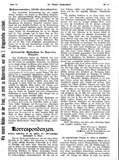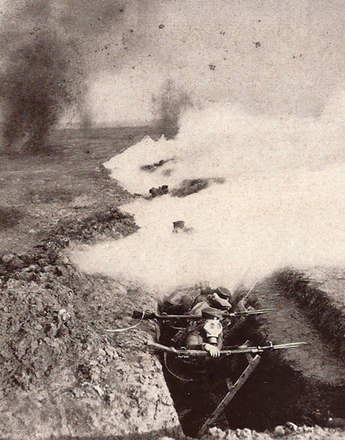Jewish soldiers in the Austro-Hungarian army
-

Ellinger, Alfred and Heim, Konrad: “We are at the front and fighting for Emperor and Fatherland”, open letter published in Dr. Bloch´s Oesterreichische Wochenschrift, the central organ for the general interests of the Jews, Vienna, 9 November 191?
Copyright: Universitätsbibliothek JCS Frankfurt am Main
The overwhelming majority of the Jewish population in the western half of the monarchy reacted with enthusiasm to the start of the war. They saw it as an opportunity to exhibit their patriotism and counter anti-Semitic prejudices. Behind this lay the desire to earn membership and respect by demonstrating Jewish commitment.
Military service, introduced in 1788 in the Habsburg Empire, extended to the Jews, and was regarded by most Jewish communities as being positive. They interpreted it as a major step on the way towards integration and an opportunity to acquire equal rights by taking on civic obligations.
During the First World War, over 300,000 Jewish soldiers served in the Austro-Hungarian army, 25,000 of them as reserve officers. In comparison with other armies at war, or even the civil sector, Jewish soldiers were less exposed to anti-Semitic discrimination, and anti-Jewish accusations were rare. As a common institution covering both parts of the Dual Monarchy, the Habsburg army saw itself as an open institution, characterised by ethnic, national and religious diversity in which differences were bridged and anti-Semitism officially not tolerated. Even if Jews were not permitted to rise to the highest ranks of the army, they were nevertheless strongly represented amongst the reserve officers and the officer corps.
The army leadership encouraged Jewish soldiers in their efforts to maintain their religious traditions. In collaboration with local Jewish associations, they arranged for kosher meals to be provided, while in regions where there were only few Jewish communities, such as on the Italian front, soldiers were paid rations money to enable them to organise their kosher food themselves. From 1916 on, the army leadership ordered the installation of kosher kitchens behind the front lines if more than 100 Jewish soldiers were serving in one unit. Small-format prayer-books issued by the Vienna Israelite Community were distributed to the soldiers. By the end of the war, 79 Jewish clerics served in the Austro-Hungarian army, holding religious services, visiting the wounded and taking on responsibility for transmitting field post in Hebrew. Like the Christian organisations at Christmas, they organised the sending of packages to the front at Chanukah.
For many soldiers of whatever religious community, celebrating the high religious feast days together was an important source of support. Religious symbols and interpretative models helped them to come to terms with the horrors of war. For Jewish soldiers there was also the fact that religious rituals represented an important expression of their Jewish identity and made them visible as a group to others. At the same time, it was in the army that many Jews first experienced close solidarity with non-Jewish comrades. The measures taken by the army leadership to support them strengthened their loyalty to the monarchy, reinforcing their view that the supranational state would protect Jews against anti-Semitic resentment. However, contrary to all hopes, integration in the Habsburg army did not lead to a greater integration into society at large.
Translation: David Wright
Berger, Michael/Römer-Hillebrecht, Gideon (Hrsg.): Jüdische Soldaten – jüdischer Widerstand in Deutschland und Frankreich, Paderborn 2012
Lichtblau, Albert (Hrsg.): Als hätten wir dazugehört. Österreichisch-jüdische Lebensgeschichten aus der Habsburgermonarchie, Wien/Köln/Weimar 1999
Rozenblit, Marsha L.: Reconstructing a National Identity. The Jews of Habsburg Austria during World War I, Oxford 2001
Schmidl, Erwin: Jüdische Soldaten in der k. u. k. Armee, in: Patka, Markus im Auftrag des jüdischen Museums Wien (Hrsg.): Weltuntergang. Jüdisches Leben und Sterben im Ersten Weltkrieg, Wien/Graz/Klagenfurt 2014, 45-51
Schmidl, Erwin A.: Juden in der K. (u.) K. Armee 1788−1918. Österreichisch Jüdisches Museum, Eisenstadt 1989
-
Chapters
- Antisemitism: A historical definition
- Jewish life in the Habsburg Empire
- Anti-liberalism – anti-capitalism – anti-Semitism
- Antisemitism as a political movement
- "I decide who is a Jew"
- The social exponents of Austrian anti-Semitism
- Anti-Semitism in other nationalities within the Habsburg Monarchy
- The Habsburg Monarchy as the guarantee of pluralistic identities
- Jewish soldiers in the Austro-Hungarian army
- The "Eastern Jews" as a pivotal point for anti-Jewish agitation
- The breakdown of the internal peace



